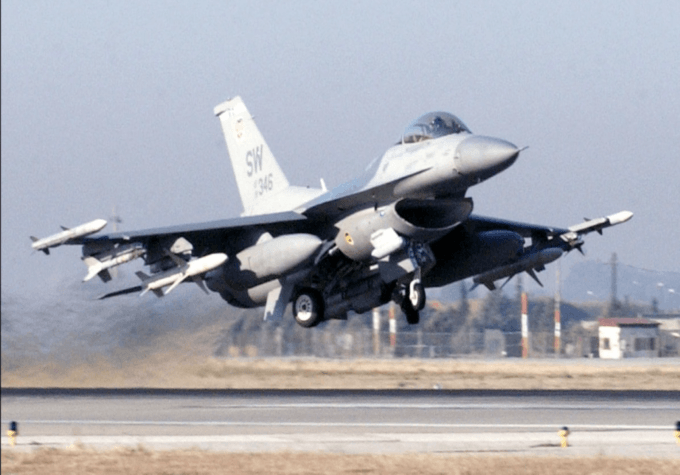
F-16 CJ. Photo: Staff Sergeant Jason Gamble, USAF.
The F-16 has been flying high since the 1970s, and is still in production today, with capabilities that the original F-16A pilots could only have dreamed of. But its USAF pilots are quite another story due to the lack of flying hours. In a recent article I calculated that the average USAF F-16CM pilot was only getting 4.9 hours a month based on data from 2020. That’s only 58.8 hours a year, well below NATO’s target of 180 hours minimum. In contrast, according to an article in The Telegraph, the cash-starved Luftwaffe reported in 2019 that more than half of its pilots received 180 hours, which is still not good, but much better than the USAF F-16 pilots. At least Luftwaffe pilots do not exhibit the rampant careerism that their American peers have thanks to their Up or Out promotion system.
USAF F-16 pilots can almost certainly handle poorly trained North Korean pilots in their outdated Soviet aircraft, but probably not many other potential adversaries, like China. I keep reading how USAF flying hours have been going down in recent years, and I wondered if this is only a recent event. Looking back to a 2002 RAND study, things were a lot different. The study compared flying hours for USAF, USN, USMC, RAF, and French air force fighter pilots and showed that the average USAF F-16 pilot received 17.3 programmed hours per month but only 16.9 actually executed (p. 25) The RAF Tornado pilots of that era were slightly better off with 17.5 hours per pilot per month. The authors concluded that “The British and French pilots have greater experience levels and more continuity in their units than U.S. pilots.” (Ibid.)
In addition to being more experienced, the British in particular have a more sensible promotion system than the Americans, which I’ll describe in detail. Lieutenant Colonel Ed Cobleigh, USAF (Ret.) said that during his time in the RAF as an exchange pilot, the promotion system worked liked this: “At about the 10-12 year point in their careers, officers were summoned down to London to the Personnel Department of MOD, Air Force Section, called ‘Air Sect’ pronounced ‘Air Sex.’ I volunteered to participate but to no avail. During the Air Sex meeting, each junior pilot was offered one of three paths forward: 1) Continue on your current path with the opportunity to retire with a small pension after 16 years of service. 2) Take the promotion track by attending staff schools and accepting staff assignments. Or, 3) Be designated as a ‘Specialist Aircrew’ whereby one more promotion was possible but the pilot would continue to do nothing but fly airplanes, no command nor staff jobs, as long as he was fit. Most guys took the 16-year option, but by then they would have to take a more lucrative job to pay off debts incurred while on active duty. The Specialist Aircrew option was for folks who loved to fly and could endure a life with a working wife of genteel poverty.” (pp. 197-198) Thus, the RAF specialist aircrew have a huge advantage over their friends flying the F-16 in the USAF, as well as all other US military pilots.
From 1960 to 1977, my late father, a pilot in the Royal Canadian Air Force, did nothing but fly, something that simply can’t happen in the USAF because of the need to keep “getting boxes checked” to qualify for promotion. My dad respected the USAF but always maintained the RCAF was better trained, and this is the case today. The USAF has some nice kit like the F-16, but without sufficient flying hours and continuity it will probably fail in combat against a first rate rival. One US general predicts a war with China may soon happen, and the entire US military needs to get its act together. It’s not much good to have great fighters like the F-16 if their pilots are not properly trained and committed to success in combat, not to getting promotions. That goes for all US military pilots as well.
NOTES
Roger Thompson “Is the USAF Really the Best Trained Air Force in The World?” CounterPunch, November 18. 2022.
Michael Peck “Bad News NATO: German Pilots Aren’t Getting Enough Flight Time” The National Interest, August 19, 2021.
Justin Huggler “German air force unable to train pilots because of shortage of planes” The Telegraph, August 5, 2019.
John F. Schank et al. Finding the Right Balance: Simulator and Live Training for Navy Units (Santa Monica, Calif.: RAND, 2002).
Ed Cobleigh And I Lived to Tell the Tales: The Life of a Fighter Pilot. Check Six Books. Kindle Edition.
This content originally appeared on CounterPunch.org and was authored by Roger Thompson.
Roger Thompson | Radio Free (2023-03-29T05:12:32+00:00) The F-16 is Still a Great Plane. USAF Pilots are Another Story. Retrieved from https://www.radiofree.org/2023/03/29/the-f-16-is-still-a-great-plane-usaf-pilots-are-another-story/
Please log in to upload a file.
There are no updates yet.
Click the Upload button above to add an update.